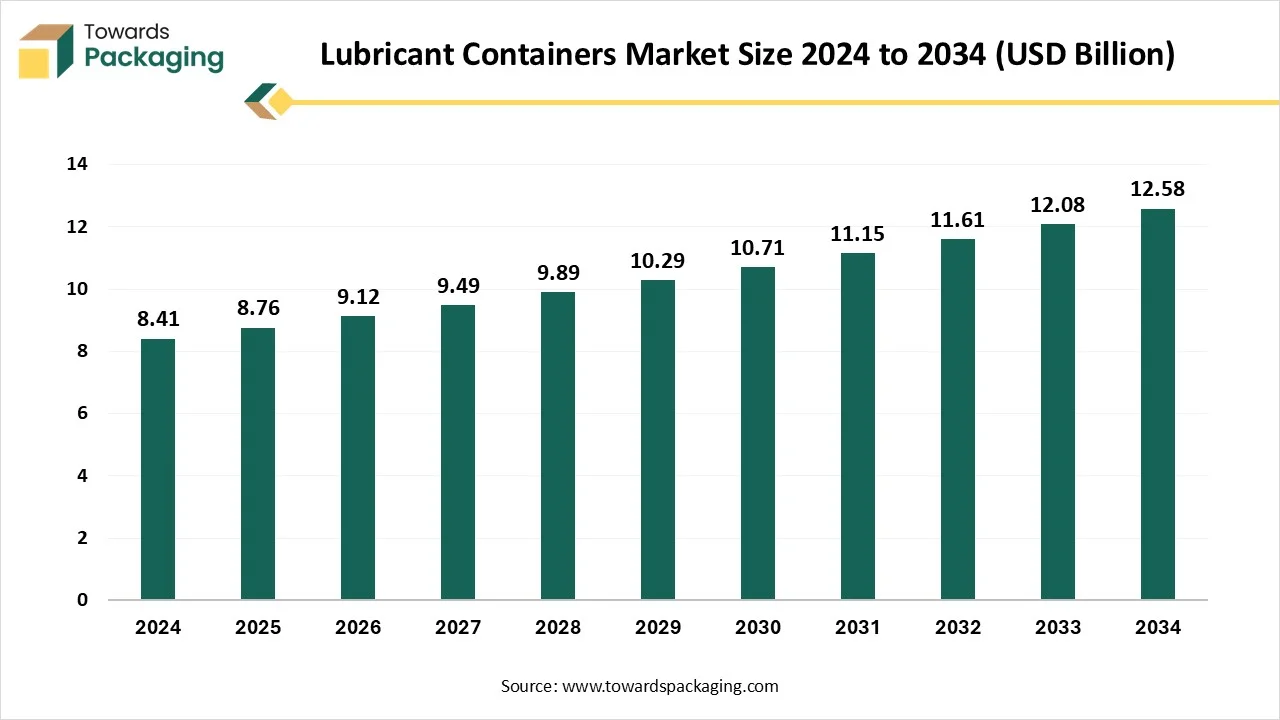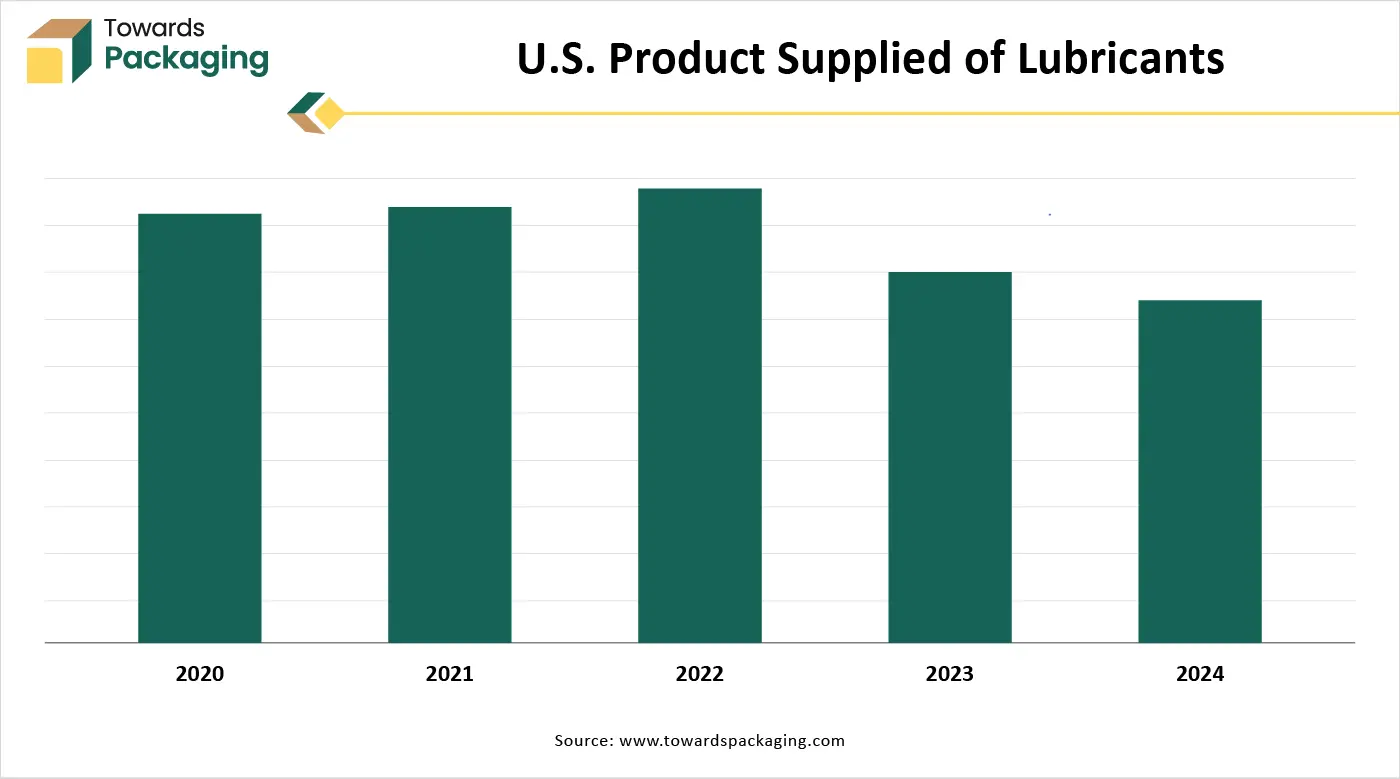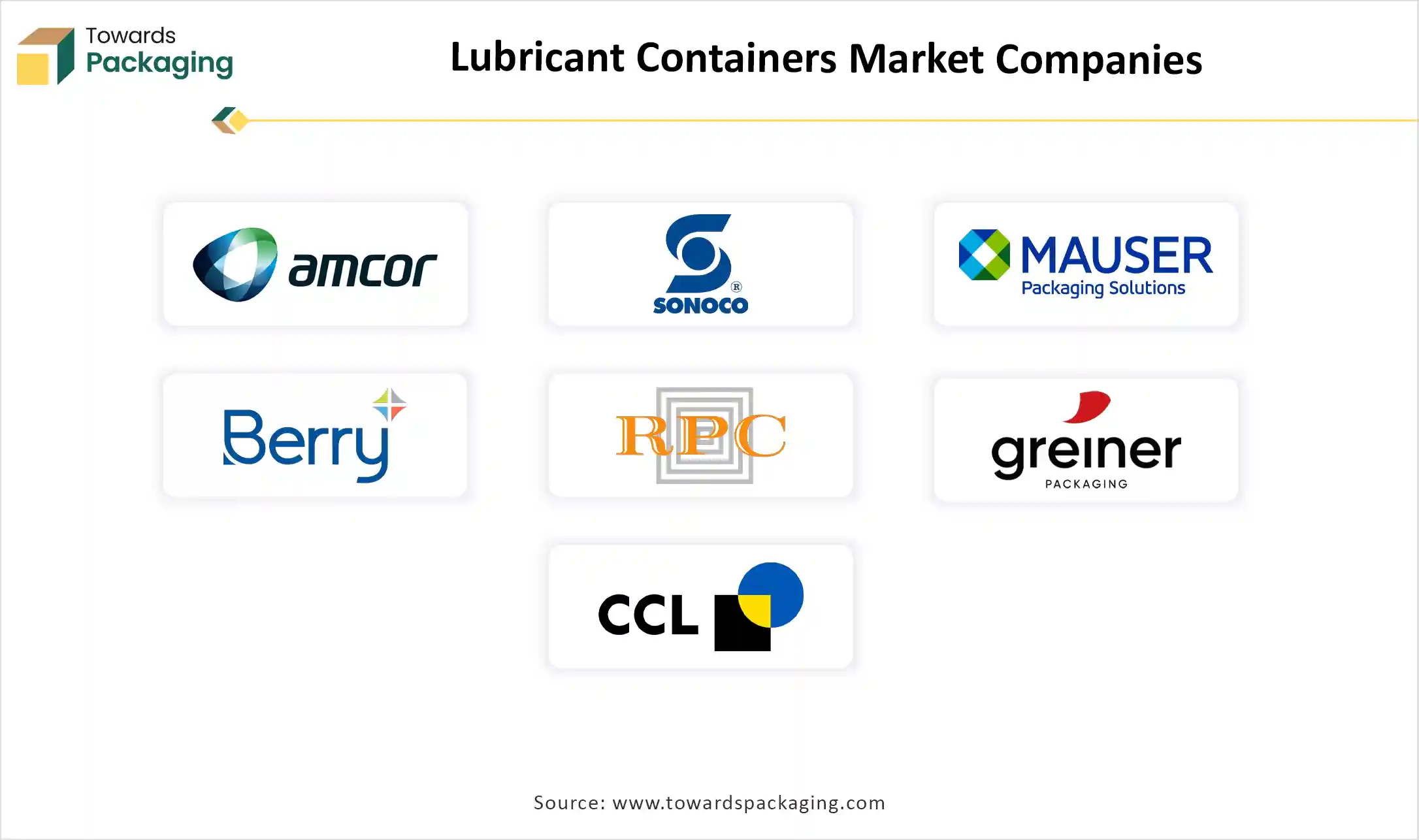December 2025
The lubricant containers market is poised for significant growth, with a projected market size of USD 8.76 billion in 2025, reaching USD 12.58 billion by 2034. This market is expanding at a CAGR of 4.12% from 2025 to 2034. Key segments include plastic, metal, and glass containers, with plastic containers dominating in 2024. The automotive sector leads as the top end-user industry, while the growing adoption of online distribution channels is expected to drive future growth. The Asia Pacific region held the highest market share in 2024, and both North America and Europe are forecast to witness the highest growth rates. Competitive players like Amcor Limited, Sonoco Products Company, and Berry Global Inc. are actively driving innovation in the market.

Lubricant containers typically refer to the packaging in which lubricants, like grease and oil, are properly stored and transported. They are usually made of materials such as high-density polyethylene (HDPE) or polypropylene. It comes in various shapes, designs, and sizes, which often range in capacities from 1 quart to 5 gallons. Lubricant containers are specifically designed to protect the lubricant from contamination and maintain its quality. These containers are accessible with robust, leak-proof, and liner-less caps.(Source:Energy Statistics and Analysis)

| Metric | Details |
| Market Size in 2024 | USD 8.41 Billion |
| Projected Market Size in 2034 | USD 12.58 Billion |
| CAGR (2025 - 2034) | 4.12% |
| Leading Region | Asia Pacific |
| Market Segmentation | By Material Type, By Container Type, By Capacity, By End-Use Industry, By Distribution Channel and By Region |
| Top Key Players | Amcor Limited, Sonoco Products Company, Mauser Group B.V., Balmer Lawrie & Co. Ltd., Berry Global Inc., RPC Group Plc |
Growing demand for spill-proof packaging solutions
The increasing spill-proof packaging solutions are expected to boost the growth of the lubricant containers market. Lubricant containers offer spill-proof packaging solutions, and these containers play a crucial role in the safe storage and transportation, ensuring the product's integrity and performance. Moreover, the rising focus on vehicle maintenance along with the increasing popularity of synthetic lubricants is expected to spur the demand for specialized containers that assist in preserving the efficacy and quality of these advanced formulations. Thus, driving the market’s revenue in the coming years.
Fluctuation in raw materials
The fluctuation in raw material costs is anticipated to hamper the market's growth. The price volatility of materials, such as plastics resins like HDPE and PP, can lead to increased container manufacturing costs. This often impacts the profitability of manufacturers involved in the lubricant containers. Such factors are restricting the growth of the lubricant container market during the forecast period.
Increasing focus on eco-friendly materials and sustainable packaging solutions
The growing focus on eco-friendly materials and sustainable packaging solutions is projected to offer lucrative growth opportunities to the lubricant containers market. Biodegradable packaging and rapid innovations in container design create significant opportunities for companies to capitalize on eco-friendly and sustainable packaging trends. In addition, the rising pressures from regulatory bodies are pushing for more eco-friendly packaging solutions, which include biodegradable plastics, recycled materials, and innovative packaging designs that minimize waste. Therefore, the shift towards sustainable packaging offers significant present opportunities for key players to enter the market with groundbreaking solutions.
The plastic containers segment accounted for the dominating share in the lubricant containers market in 2024, owing to its low cost, versatility, and lightweight. These containers are extensively adopted in several industries, such as automotive, manufacturing, industrial, and others, due to their ability to withstand harsh environmental conditions. However, rising regulatory pressures and increasing environmental concerns are expected to accelerate the growth of sustainable alternatives, leading to the development of recyclable and biodegradable plastic materials.
On the other hand, the metal containers segment accounted for the considerable growth in the global market over the forecast period, fuelled by the rising focus on recyclability and durability. These containers are widely used in the industrial and automotive sectors for storing and transporting high-performance lubricants. Moreover, the increasing focus on sustainability and the circular economy is expected to propel the demand for metal containers, as metal lubricant containers can easily be reused and recycled.
The bottles dominated the lubricant containers market in 2024, owing to the increasing use of bottles in the industrial and automotive sectors for packaging small to medium volumes of lubricants. Bottles are the most widely used of lubricant container types, and their ability to protect against external factors, gaining popularity for industrial and consumer applications.
On the other hand, the cans segment is expected to grow at a notable rate. Cans are widely used in the automotive and marine sectors owing to their superior protection against contamination and are ideal for storing and transporting high-performance lubricants. Cans are available in various shapes, sizes, and designs, providing manufacturers with significant opportunities for customization. In addition, cans are increasingly gaining popularity owing to their recyclability, durability, and ability to withstand severe climatic conditions.
The less than 1-liter segment dominated the market share in 2024. These lubricant containers are widely utilized for the packaging of various small volumes of lubricants, gaining immense popularity for consumer applications. On the other hand, the 1 to 5 liters is expected to sustain its position throughout the forecast period, owing to the increasing usage of these containers in the automotive and industrial sectors, mainly for packaging medium volumes of lubricants.
The automotive sector segment accounted for the highest growth rate in the lubricant containers market, owing to the rising demand for lubricant containers in the automotive sector. The rising focus on vehicle maintenance, along with the increasing popularity of synthetic lubricants, is expected to accelerate the segment’s growth in the coming years. In addition, the rising adoption of Electric Vehicles (EVs) is likely to spur the demand for lubricant containers.
On the other hand, the industrial sector is expected to grow at a significant CAGR in the lubricant containers market, owing to the growing focus on sustainability and the rising expansion of the manufacturing and energy industries. Moreover, the rising shift towards the adoption of advanced machinery across various industries is anticipated to increase the demand for lubricant containers during the forecast period.
The offline channels segment held the largest share of the satellite data services market. Offline channels generally include retail stores, wholesalers, and distributors. The rising convenience of purchasing products in person is anticipated to accelerate the segment’s growth. In addition, the robust presence of established distribution networks in several countries around the world and the rising focus on customer service are expected to propel the demand for lubricant containers through offline channels.
On the other hand, the online segment is expected to witness remarkable growth during the forecast period, owing to the increasing popularity of e-commerce, and digitalization is likely to encourage manufacturers to explore various online distribution strategies. The growth of the segment is mainly driven by the rising demand for lubricant containers through online channels and the increasing availability of a wide range of products.
Asia Pacific led the lubricant containers market with the highest share in 2024. In the region, Countries such as China, India, South Korea, and Japan are the major contributors to the market, owing to the rapid expansion of the automotive and industrial sectors The region's rapid growth is attributed to the rising infrastructure development, favorable government policies, rising disposable incomes, and robust presence of key lubricant manufacturers and suppliers.
The surging demand for eco-friendly materials and sustainable packaging solutions is expected to boost the regional growth of the lubricant containers market as industries are increasingly prioritizing environmentally responsible practices. Moreover, the rapid technological advancements in production processes, including AI-powered quality control and automation, are enhancing cost-efficiency and sustainability. The increasing integration of biodegradable materials focuses on addressing rising environmental concerns while meeting regulatory requirements.
North America and Europe are expected to witness the highest CAGR during the forecast period, owing to the rising expansion of the automotive and industrial sectors, which has led to the rising demand for lubricants and which in turn fuels the growth of the lubricant containers market. The growing focus on innovation and sustainability, increasing adoption of smart packaging solutions such as RFID-enabled tracking and QR-code authentication, and rising consumer preferences for sustainable packaging. The market is experiencing increasing adoption of advanced packaging solutions in the regions to meet the rising demand for lubricants.

By Material Type
By Container Type
By Capacity
By End-Use Industry
By Distribution Channel
By Region
December 2025
November 2025
November 2025
October 2025